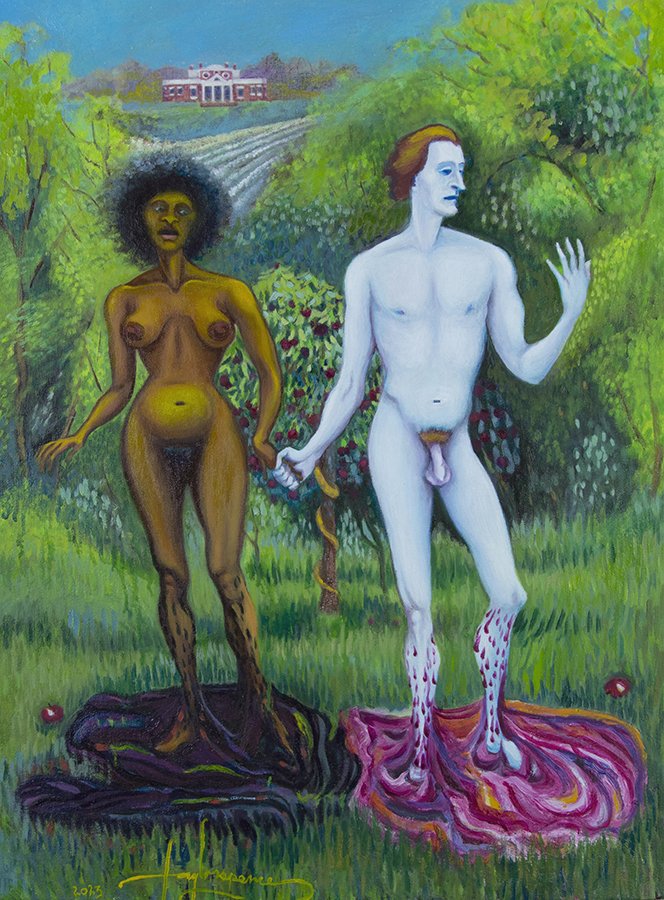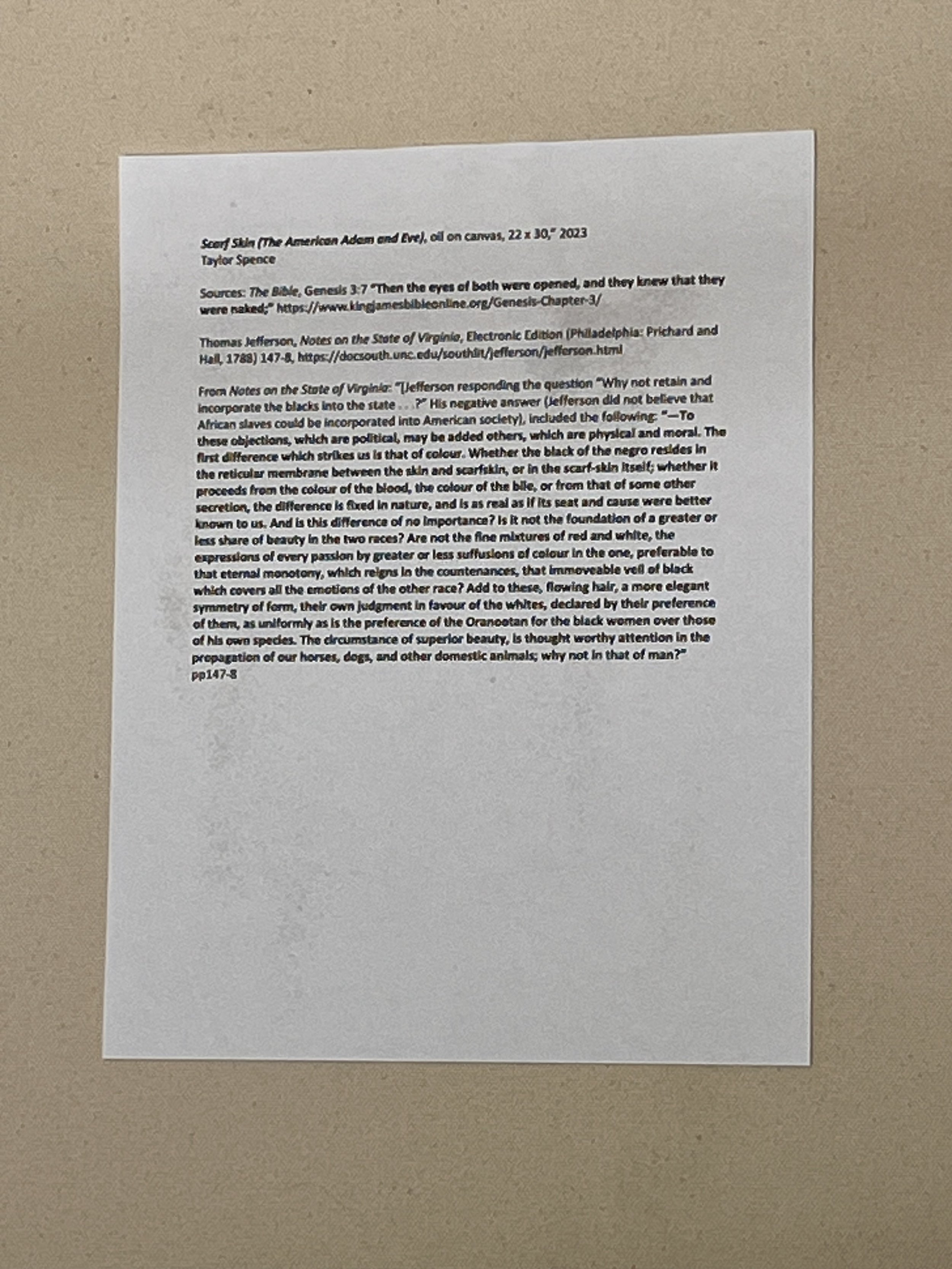This little allegorical painting explores the ways that our beliefs affect how we see the world, even to the point of changing our perceptions of reality.
In the Bible, Eve and Adam experience a moment of radical vision when they eat of the fruit of the Tree of the Knowledge of Good and Evil. Once they take a bite of that apple, they see that they are naked and are ashamed.[1]
What awareness might the fruit of the Tree of the Knowledge of settler-colonialism have provided people in 18th-century America? In fact, some people clearly saw that stealing others’ homes and resources and kidnapping and exploiting human beings for profit was evil. Others either could not or would not believe the evidence of their own eyes.
The American Adam, Thomas Jefferson, wrote the foundational document of the United States, the Declaration of Independence in 1774. Later, while governor of the state of Virginia, he wrote Notes on the State of Virginia (published in 1780) to answer a series of questions posed by François de Barbé Marbois, Head of the French legation to the new nation.
A passage in this document provided the basis for my painting.
The Frenchman asked Governor Jefferson “why not retain and incorporate the blacks into the state . . .” rather than deport them back to Africa, if, as Jefferson had contended, slavery would naturally come to an end with democracy?
While Jefferson believed that chattel slavery would end, he did not think that the integration of the two races could work in the new nation. He based this view on the historical grievances between the races – what he termed “political” reasons -- as well as his belief in the inherent inferiority of African people, what he called “physical and moral” reasons. Regarding this latter set of reason, Jefferson writes, “the first difference which strikes us is that of colour:
“Whether the black of the negro resides in the reticular membrane between the skin and scarfskin, or in the scarf-skin itself; whether it proceeds from the colour of the blood, the colour of the bile, or from that of some other secretion, the difference is fixed in nature, and is as real as if its seat and cause were better known to us.”
Skin color, according to Jefferson, was the visible sign of a fundamental difference in the capabilities of African-Americans and Caucasian-Americans. Jefferson believed that white skin was more beautiful than black, and that physical beauty was itself a sign of intellectual and moral capacity:
“And is this difference of no importance? Is it not the foundation of a greater or less share of beauty in the two races? Are not the fine mixtures of red and white, the expressions of every passion by greater or less suffusions of colour in the one, preferable to that eternal monotony, which reigns in the countenances, that immoveable veil of black which covers all the emotions of the other race?”
Physical beauty and the ability to express sentiment were the hallmarks of refinement and intelligence according to Jefferson, who was a typical Enlightenment thinker. In his opinion, a white person’s superior beauty was based in their skin’s ability to reveal the play of emotions. Black skin, according to him, was like negative space, revealing nothing. Yet he knew that African-American People possessed a nearly infinite range of skin colors. He lived in close and intimate proximity to them, even to the extent of engaging in sexual relations with them. He had sired children, who possessed a variety of skin tones. He also knew that African-Americans felt the entire range of human emotions. He called for and witnessed their punishments and heard and saw their emotional appeals to not be sold or to not see their children or spouses sold. This is Jefferson at his most blind.
The cause of his blindness was racism and his belief in a particular racist lie about desire. As he elaborates, African-American people represented a significant threat to the well-being of the nation because they were inexorably drawn to want to have sex with white people:
“Add to these, flowing hair, a more elegant symmetry of form, their own judgment in favour of the whites, declared by their preference of them, as uniformly as is the preference of the Oranootan for the black women over those of his own species. The circumstance of superior beauty, is thought worthy attention in the propagation of our horses, dogs, and other domestic animals; why not in that of man?”[2]
While not the originator of this particular lie (dark-skinned lust for white skin), Jefferson gives it a new lease on life by employing a supposedly scientific fact about a non-human animal, the orangutang, to buttress his claim. The European discovery of the orangutang in the seventeenth-century fueled racist theories that placed Europeans at the most civilized end of an evolutionary spectrum, orangutangs at the other end, and Africans somewhere in the middle.
Jefferson’s view of human progress was predicated on desire. He believed that inferior beings naturally desired superior ones. As orangutangs wanted African women rather than females of their own species, so too did African people naturally want whites. Africans’ cross-racial desire was proof of their inferiority, and it made them dangerous, while whites, Jefferson implies, naturally desired only other whites.[3] Thus, the real danger of allowing African-Americans to remain in the nation, a threat which they themselves were incapable of hiding, was that they their desire would result in mixed-race children, denigrate the white-skinned population, and thus weaken the nation as a whole.
The irony here is, of course, staggering, but also tragic. Jefferson was in love with the idea of whiteness, yet his deeper love was for racism itself. Racism clarified the identity of the new nation and supported everything that mattered to him: his beliefs in the fundamental nature of white liberty and equality, his sense of white superiority, and his belief in his right to govern as a white man. Even as he could not see African-Americans as they were, he could not see himself as he was.
In the painting, the eyesight of the American Eve is not similarly impaired. She understands that the white man holding onto her and lost in a racist reverie poses a mortal threat. Once she has the knowledge of good and evil, she understandably tries to get away.
Both Adam and Eve stand in puddles of their scarf skins, one black and the other pink, which eating the apple has caused them to shed. These membranes lie on the ground as inverted reflections of how they used to see. Like Eve, we also see clearly, understanding the difference between good and evil.
[1] Book of Genesis, Chapters 2 and 3 “OFFICIAL KING JAMES BIBLE ONLINE.”
[2] Jefferson, Jefferson’s Notes on the State of Virginia; with the Appendixes--Complete., 147–48.
[3] Though jarring to our present-day moral sensibilities, Jefferson’s reasoning was part of a larger intellectual undertaking then happening in late-18th century Europe and America, where people were beginning to use science to justify imperialism with racism. Buchan and Andersson Burnett, “Knowing Savagery,” 122–25; Orangutangs, first brought to Europe in the 17th century, became part of a developing racial discourse that situated Africans somewhere between savage and civilized. Sebastiani, “A ‘Monster with a Human Visage’: The Oragngutan, Savagery, and the Borders of Humanity in the Global Enlightenment,” 90.

